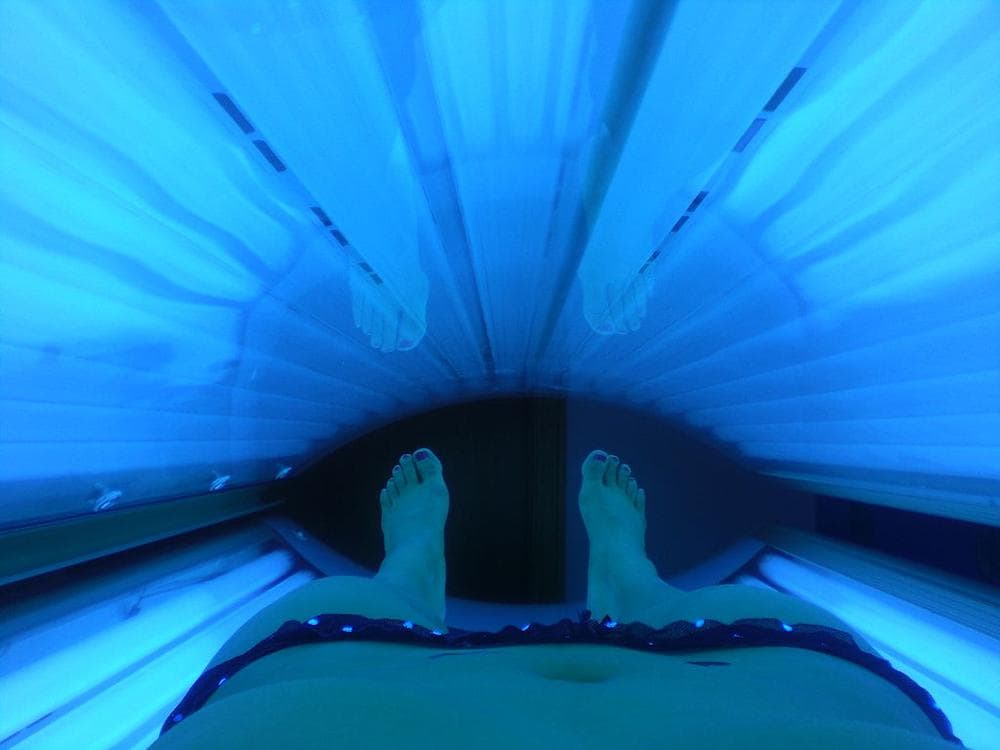Advertisement
Ten Latest Health Reasons To Swear Off Tanning Salons

Summers, Glenna Kohl worked as a sun-drenched lifeguard in her Cape Cod hometown of Barnstable. Winters, she developed a feel-good habit of going to tanning salons. "It was kind of a guilty thing, like having an ice cream," said her father, Robert Kohl.
At age 22, Glenna was diagnosed with advanced melanoma, and though she braved all possible treatments, she died three years later.

Glenna was athletic, vegetarian and deeply interested in health, but there was a lot she didn't know a decade ago as she deepened her tan — because she couldn't. There were studies that had not yet been conducted, official health pronouncements not yet made, public messaging not yet spread. Everyone knew indoor tanning could take a toll on your skin just like the sun — but not exactly how great a risk it posed. People knew to avoid sunburn, but tanning beds could be controlled, right?
Glenna could not prove that it was indoor tanning rather than outdoor sun that caused her melanoma, said Robert Kohl, who now helps run the Glenna Kohl Fund For Hope. But he thinks that if today's overwhelming body of evidence on indoor tanning had been out there back then, "it might have been enough to keep her out of there. It probably would have. She was a smart girl and she wouldn't have taken it lightly."
Over the last few years, study after study has established and calculated the health risks of indoor tanning, to the point that California and Vermont have recently banned it for people under 18, and New York for those under 17. (Massachusetts has enacted no such ban, despite multiple efforts, and the legislature failed to pass a more limited ban in its last session.)
Just this week, an overview of previous studies, published in the medical journal BMJ, estimated that in the United States, indoor tanning leads to more than 170,000 cases a year of two increasingly common non-melanoma types of skin cancer, basal cell carcinoma and squamous cell carcinoma. The younger you are when you tan, it noted, the higher your risk.
[module align="left" width="half" type="pull-quote"]'We’re not anywhere near the beginning of the tipping point of the epidemic.'[/module]
I asked Alan Geller of the Harvard School of Public Health, a leading researcher on the epidemiology of skin cancer, to sum up what we know now that we didn't know then. Here's what I found his most disturbing statistic:
"Most projections will say that about 40 uses [of a tanning bed] during one’s lifetime elevates one’s risk of melanoma about 55%," he said. "So if you do the math, it means basically a 1-1/2 % extra risk for melanoma for each time you use it."
Just to put that in perspective: An American's overall risk of getting melanoma is about 1 percent, or 1 in 100. So adding one and a half percent of that to it is far from a guaranteed death sentence. But there it is, a number you can hang your hat on when you wonder, "Is this worth it?"
And for the bigger picture, you have to multiply that added risk by tens of millions of people, mainly young women. An estimated 30 million Americans tan indoors. Geller says that for him, some of the most concerning numbers came out just recently, from a national survey on the popularity of indoor tanning.
Published by the CDC this May, it found that in 2010, nearly one-third of young white women used indoor tanning. (Other research has found that 15 percent of 15-year-old girls use tanning beds, and more than double that by 17.)
Such numbers quash any hope that young people's interest in indoor tanning may be fading, Geller said.
"The number of cases of melanoma and other types of skin cancer related to tanning bed use is already far too high," he said. "But we’re not anywhere near the beginning of the tipping point of the epidemic based on how many young people are currently using tanning beds and, disturbingly, how frequently they do so."
Let's sum up ten points that may eventually help tip that balance. The first you've just heard:
1. Added melanoma risk per session: 1.5%
And the extra risk adds up. If you start before age 30, your melanoma risk goes up by 75%.
2. Tanorexic, tanaholic, call it what you will...
...but it's clear that a great many indoor tanners feel the need to do it often. It is another of Geller's greatest concerns, he said, that the recent survey found so much frequent use of tanning beds. White women who tan indoors do it an average of 20 sessions a year.
Why might that be? Appearance aside, UV or ultraviolet light gives pleasure, to the point that it can be addictive. Dr. Mary Brady of Memorial Sloan Kettering Cancer Center writes in a recent cancer journal article:
Recent studies provide a fascinating potential explanation for the growth of the tanning bed industry despite the known health risk of excessive UV exposure. It appears that UV radiation has positive, and potentially addictive effects, on mood. In a small but intriguing study by Feldman et al, young adults blinded to the difference chose tanning beds with UV as opposed to beds with the exact conditions but absent the UV radiation. Indoor tanning has been associated with relaxation and endorphin release. These additional positive effects can lead to addictive behavior in tanning bed users and may explain the increasing popularity of tanning salons despite the common-sense awareness of the damaging effects of UV radiation on the skin.
3. Daunting melanoma statistics
From the Melanoma Foundation of New England:
Melanoma rates are increasing faster than nearly all other cancers with an epidemic growth rate of 3% annually.
In 2012, an estimated 76,250 new cases of melanoma will be diagnosed, with approximately 9100 deaths yearly from the malignant melanoma and another 3000 deaths from non melanoma skin cancers.
More than one person dies every hour from melanoma.
4. Even higher risk of other skin cancers
In a major study of more than 70,000 women over 20 years, researchers reported earlier this year that indoor tanning significantly increased the risk not just of melanoma but of two other skin cancers, basal cell carcinoma and squamous cell carcinoma. They are not as deadly as melanoma but far more common.
Similarly, another recent study found that patients who used tanning beds were at a 69% higher risk for early-onset basal cell carcinoma.
5. The World Health Organization says 'carcinogen'
In 2009, the WHO's International Agency for Research on Cancer shifted the definition for indoor tanning devices from "probable" carcinogen to its highest risk level, 'Carcinogenic to humans," putting them in the same class as tobacco and asbestos.
6. It's not just cancer doctors who oppose it.
Just about any medical group you can name is against indoor tanning, and U.S. health authorities also offer a chorus of warnings about the risks of indoor tanning. President Obama's health care overhaul adds a 10% tax on indoor tanning.
The FDA, which is considering tighter regulations, points out here that your 'healthy glow" is actually a sign of skin damage, and that risks include not just cancer but premature aging, immune suppression, allergies and eye damage.
And the CDC not only warns of such risks, it also knocks down positive "myths" about indoor tanning:
“Tanning indoors is safer than tanning in the sun.”
Indoor tanning and tanning outside are both dangerous. Although tanning beds operate on a timer, the exposure to ultraviolet (UV) rays can vary based on the age and type of light bulbs. You can still get a burn from tanning indoors, and even a tan indicates damage to your skin.
“I can use a tanning bed to get a base tan, which will protect me from getting a sunburn.”
A tan is a response to injury: skin cells respond to damage from UV rays by producing more pigment. The best way to protect your skin from the sun is by using these tips for skin cancer prevention.
“Indoor tanning is a safe way to get vitamin D, which prevents many health problems.”
Vitamin D is important for bone health, but studies showing links between vitamin D and other health conditions are inconsistent. Although it is important to get enough vitamin D, the safest way is through diet or supplements. Tanning harms your skin, and the amount of time spent tanning to get enough vitamin D varies from person to person.
7. 'Worse than a sunny beach at midday'
Dr. Brady writes in her essay, "Public Health and the Tanning Bed Controversy:"
Evidence that tanning beds emit levels of radiation above those normally experienced in midday on a sunny beach is particularly disconcerting. Gerber et al measured the biologic activity of the UV output of conventional tanning beds and determined that the erythema-effective irradiance was equivalent to or exceeded the emission of the midday sun in southern Europe.
[module align="left" width="half" type="pull-quote"]Researchers have equated one half-hour of tanning bed use with many hours of beach exposure.[/module]
In fact, research suggests that the doses of Type A ultraviolet light emitted by high-pressure tanning units may be as much as 10 to 15 times higher than that of the midday sun, an intense exposure not repeated in nature, Geller said. Researchers have equated one half-hour of tanning bed use with many hours of beach exposure, he said.
8. Costs add up
Dr. Brady also points out that basal cell carcinoma is the most common cancer diagnosis in the United States, and can involve facial surgery. "As we face a future of increasing scarcity of health care dollars and an aging population," she writes, it makes sense to reduce the costs of treating the most common cancer.
9. Ugliness and irony
Glenna Kohl's father, Robert, sees great irony in the tanning industry's efforts to appeal to young girls who want to enhance their looks. "It's not only about melanoma and the risk of cancer," he said, "you also turn your skin to leather and get wrinkles earlier, and sunspots. You'd think the people who are all about looking good would be smart enough to say, 'Wait a minute, what's this going to do to me later?' But kids don't think down the road."
[module align="right" width="half" type="pull-quote"]'Dying is not a good risk to take.'[/module]
"Dying is not a good risk to take," he said. If he were speaking to a girl who was considering a tanning session, he said, "I'd stress the fact that I've seen it first-hand. And not only was my daughter sick for three years, but because of all the treatments she went through, the suffering was unbearable, to try to endure and cure herself."
"I would say, 'Girls, don't be stupid.'"
10. If you happen to be reading this in New England...
According to the Melanoma Foundation of New England, the region has a higher-than-average rate of melanoma.
(By the way, with this robust body of evidence, why has Massachusetts not passed an under-18 ban like Vermont and California? It's not for lack of trying; backers of a ban have repeatedly introduced a bill into the legislature, and it has repeatedly stalled. I asked Robert Kohl why he thought that was, and he answered simply: "It’s big money. It’s a $5-billion industry.")
Oh, yes, and the ultimate reason to walk on by the tanning salon, possible more powerful than all the others: The visuals of the New Jersey tanning mom.
This program aired on October 5, 2012. The audio for this program is not available.

